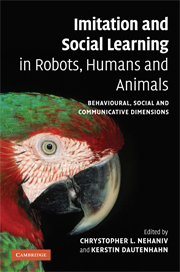 Imitation and Social Learning in Robots, Humans and Animals
Imitation and Social Learning in Robots, Humans and Animals Published online by Cambridge University Press: 10 December 2009
Introduction
Social learning, matched behaviour and imitation are important classes of mechanisms whereby knowledge may be transferred between agents (biological, computational or robotic autonomous systems). They comprise key mechanisms necessary for the evolution and development of social intelligence and culture. Researchers from across disciplines have begun coming together to understand these mechanisms with ever more sophisticated models.
While the importance of Social Learning has grown increasingly apparent to psychologists, ethologists, philosophers, linguists, cognitive scientists and computer scientists, biologists, anthropologists and roboticists, the workers in the field are often unaware of relevant research by others in other disciplines. Social learning has lacked a rigorous foundation and only very few major interdisciplinary publications have been available on the subject for researchers in artificial intelligence or psychology interested in realizations of the mechanisms they study. By bringing social learning techniques into computer and robotic systems, the door is being opened for numerous applications that will allow the acquisition of skills, programs and behaviours automatically by observation in human–computer interfaces (e.g. Lieberman, 2001), human–robot interaction important in service robotics and other applications where robot assistants or companions need to learn from humans, and industrial applications such as automated factory floors in which new robots can acquire skills by observing the behaviour of other robots or humans. Models from psychology and biology are being validated and extended as scientists from these fields interact with collaborators from sciences of the artificial, while the latter benefit from the insight of their colleagues in the natural and social sciences in the harnessing of social learning in constructed systems.
To save this book to your Kindle, first ensure [email protected] is added to your Approved Personal Document E-mail List under your Personal Document Settings on the Manage Your Content and Devices page of your Amazon account. Then enter the ‘name’ part of your Kindle email address below. Find out more about saving to your Kindle.
Note you can select to save to either the @free.kindle.com or @kindle.com variations. ‘@free.kindle.com’ emails are free but can only be saved to your device when it is connected to wi-fi. ‘@kindle.com’ emails can be delivered even when you are not connected to wi-fi, but note that service fees apply.
Find out more about the Kindle Personal Document Service.
To save content items to your account, please confirm that you agree to abide by our usage policies. If this is the first time you use this feature, you will be asked to authorise Cambridge Core to connect with your account. Find out more about saving content to Dropbox.
To save content items to your account, please confirm that you agree to abide by our usage policies. If this is the first time you use this feature, you will be asked to authorise Cambridge Core to connect with your account. Find out more about saving content to Google Drive.